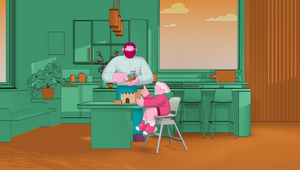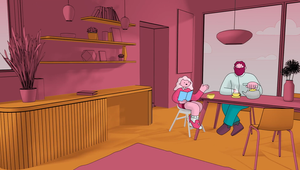
Mill STRATA VR Experience Uses Your Brain to Transport You Through Five Fantastical Worlds

The Mill's STRATA project is a responsive VR experience driven by biometrics. STRATA tunes into your heart rate, breathing, stress levels and brain waves to remix a game engine world around you. The stunning immersive experience connects us to our own emotional state, teaching us to calm and focus our minds.
Based on biofeedback techniques, the visuals within STRATA respond and react to your physiological and neurological data. This in turn helps create awareness of the user’s autonomic nervous system. The goal is use our own biometrics as a controller, calming oneself to levitate upwards through five fantastical worlds.
Rama Allen, ECD at The Mill's New York studio, reveals more about the VR experience.
Q> How did The Mill get involved with the V&A?
RA> The Mill and The V&A were brought together through friends Catherine Ince (Senior Curator, V&A East) and Jarrad Vladich (Emerging Tech Producer, The Mill) who sparked early conversations with the Videogame Team at the V&A. They gave us an insight into their exciting upcoming events which in turn sparked us into action to create a robust event version of the STRATA experience, which I had previously showcased on the Innovation Stage at this year’s Cannes Lions.
Q> What gave you the idea of transforming biofeedback experiments into a VR experience?
RA> STRATA was born out of twin fascinations: how we interact with digital media and how we can see the body's invisible machinations. You can connect these two things via standard consumer wearables, but those have always felt dissatisfying to me — you can read your heartbeat on your wrist, so what?
I wanted to use technology to create a nontechnical relationship with ourselves, by creating a biofeedback system that’s felt rather than read, in an effort to complete the theatre of immersion and amplify it with the authenticity and power of real-time data feedback. VR, after all, is about transport, and the dream of the experience is quite fragile. To distract from the whole is to interrupt the dream and do a disservice to the medium and the feeling.
I'm also interested in new control and interaction concepts. Can our films and games bend to our emotions? Can our autonomic nervous systems play a role in navigating and creating richer experiences?
Q> What are the five different worlds featured in STRATA and where did you draw creative inspiration from to create these new landscapes?
RA> The STRATA universe is made up of a subterranean lake, a meadow, a floating island, an aurora and nebula.
I love myth, hallucination and otherworldly constructs. A lot of my work is informed by authors like Borges and my own dream states - magical architecture, basically.
For STRATA, I imagined what our ‘innerverse’ might look like translated into landscapes. I wanted the structure to be a continuous, chaptered progression that one could seamlessly levitate through, so the design became a meditation on layers that feels like an emergence from dark and solid environments upwards to ephemera and light.

Q> What are STRATA’s potential uses?
RA> There’s been a great deal of interest! We’re still very much in the prototype phase, but are nearing solutions to create a working format for a diverse range of permanent installations, from the fine arts to medical facilities, as well as a publishable model for wider distribution. I'm incredibly excited to see where and how STRATA evolves.
Q> Tell us about the reaction from users so far?
RA> This might be the most rewarding work I’ve ever created. The responses have run from joyful tears to calm awe. It seems to quiet our internal metronomes of anxiety, so a lot of people immediately want others to try it, to share that experience. Of course, there are some who don’t quite connect with it, but we'll continue to improve it. In the end, I just want people to feel something, whether it's simply beauty and relaxation, or deeper mindfulness and meaningful therapeutic shifts.

Q> Do you see the realm of VR becoming more geared towards educational uses such as this, rather than just as a form of entertainment?
RA> I do. Any new medium in its infancy will look backwards to find success. In our case, films and video games are obvious connections, but I believe VR has far greater possibilities that can only be found through more divergent thinking. I'm hoping to see more experiments like STRATA out there in the world. We must focus on VR's strengths and challenges. We must take chances. We must dream in new ways for this new medium.















